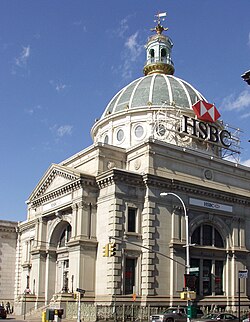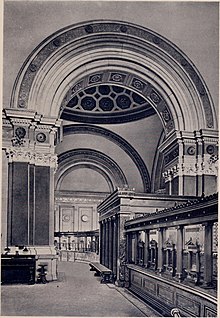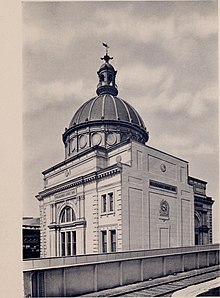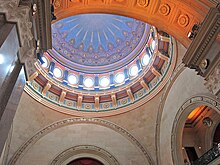
Kings County Savings Bank is a former bank building at 135 Broadway in the Williamsburg neighborhood of Brooklyn in New York City. It is an example of French Second Empire-style architecture. Construction of the building began in 1860, to designs of William H. Willcox of Brooklyn, in partnership with prominent New York architect Gamaliel King, working as King & Willcox. The structure was continuously occupied by banks until the 1990s. The Williamsburg Art & Historical Center has operated the building since 1996.
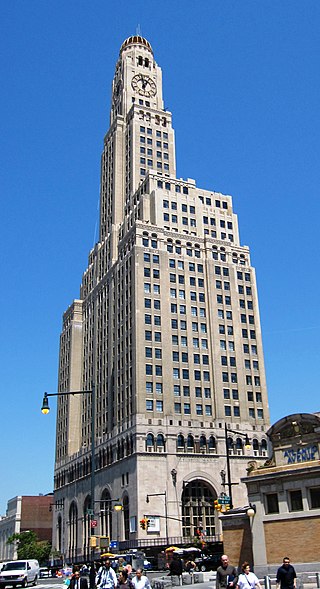
The Williamsburgh Savings Bank Tower, also known as One Hanson Place, is a skyscraper in the Fort Greene neighborhood of Brooklyn in New York City. Located at the northeast corner of Ashland Place and Hanson Place near Downtown Brooklyn, the tower was designed by Halsey, McCormack and Helmer and constructed from 1927 to 1929 as the new headquarters for the Williamsburgh Savings Bank. From the time of its construction until 2009, One Hanson Place was the tallest building in Brooklyn at 41 stories and 512 feet (156 m) tall.

1 Wall Street is a mostly residential skyscraper in the Financial District of Lower Manhattan, New York City, on the eastern side of Broadway between Wall Street and Exchange Place. 1 Wall Street, designed in the Art Deco style, is 654 feet (199 m) tall and consists of two sections. The original 50-story building was designed by Ralph Thomas Walker of the firm Voorhees, Gmelin and Walker and constructed between 1929 and 1931, while a 36-story annex to the south was designed by successor firm Voorhees, Walker Smith Smith & Haines and built between 1963 and 1965.
14 Wall Street, originally the Bankers Trust Company Building, is a skyscraper at the intersection of Wall Street and Nassau Street in the Financial District of Manhattan in New York City. The building is 540 feet (160 m) tall, with 32 usable floors. The original 540-foot tower is at the southeastern corner of the site, and a shorter annex wraps around the original tower.

The Williamsburgh Savings Bank was a financial institution in Brooklyn, New York from the mid-19th to the mid-20th centuries. The bank was incorporated in 1851 under legislation passed by the New York State Assembly. The bank continued to operate until a series of mergers brought the bank into the HSBC group late in the 20th century.
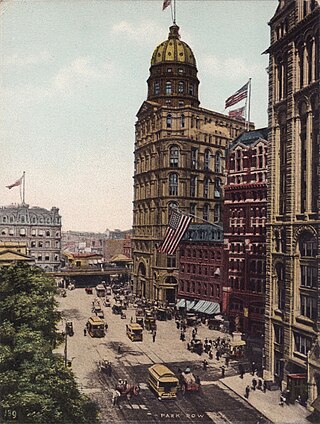
The New York World Building was a building in the Civic Center of Manhattan in New York City, along Park Row between Frankfort Street and the Brooklyn Bridge. Part of Lower Manhattan's former "Newspaper Row", it was designed by George B. Post in the Renaissance Revival style, serving as the headquarters of the New York World after its completion in 1890. The New York World Building was the tallest building in New York City upon completion, becoming the first to overtop Trinity Church, and was by some accounts the world's tallest building.

The American Surety Building is an office building and early skyscraper at Pine Street and Broadway in the Financial District of Manhattan in New York City, across from Trinity Church. The building, designed in a Neo-Renaissance style by Bruce Price with a later expansion by Herman Lee Meader, is 388 feet (118 m) tall, with either 23 or 26 stories. It was one of Manhattan's first buildings with steel framing and curtain wall construction.

55 Wall Street, formerly the National City Bank Building, is an eight-story building on Wall Street between William and Hanover streets in the Financial District of Lower Manhattan in New York City, New York, United States. The lowest three stories were completed in either 1841 or 1842 as the four-story Merchants' Exchange and designed by Isaiah Rogers in the Greek Revival style. Between 1907 and 1910, McKim, Mead & White removed the original fourth story and added five floors to create the present building. The facade and part of the interior are New York City designated landmarks, and the building is listed on both the New York State Register of Historic Places and the National Register of Historic Places (NRHP) as a National Historic Landmark. It is also a contributing property to the Wall Street Historic District, listed on the NRHP.
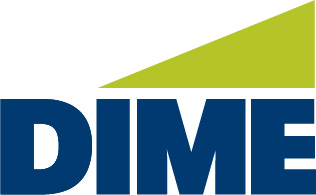
The Dime Community Bank, originally known as the Dime Savings Bank of Williamsburgh, is a local, FDIC-insured bank headquartered in Hauppauge, NY. Founded in 1864, the bank was originally based in the Williamsburg neighborhood of Brooklyn, New York, and continues to operate with a strong market presence in this area. In 2017, Dime moved its headquarters to Brooklyn Heights. On Monday, February 1, 2021, Bridge Bancorp Inc. and Dime Community Bancshares successfully closed on a merger of equals. The bank headquarters is currently in Hauppauge, NY.

108 Leonard, formerly known as 346 Broadway, the New York Life Insurance Company Building, and the Clock Tower Building, is a residential structure in the Tribeca neighborhood of Manhattan in New York City, United States. Built from 1894 to 1898, the building was constructed for the New York Life Insurance Company. Stephen Decatur Hatch created the original plans while McKim, Mead & White oversaw the building's completion. The building occupies a city block bounded by Broadway to the west, Leonard Street to the north, Lafayette Street to the east, and Catherine Lane to the south. It is a New York City designated landmark and is listed on the National Register of Historic Places.

49 Chambers, formerly known as the Emigrant Industrial Savings Bank Building and 51 Chambers Street, is a residential building at 49–51 Chambers Street in the Civic Center neighborhood of Manhattan in New York City. It was built between 1909 and 1912 and was designed by Raymond F. Almirall in the Beaux-Arts style. The building occupies a slightly irregular lot bounded by Chambers Street to the south, Elk Street to the east, and Reade Street to the north.
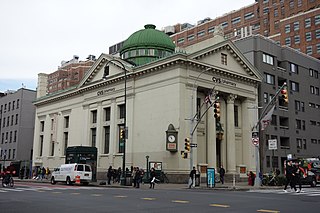
The New York Savings Bank Building is a former bank building in the Chelsea neighborhood of Manhattan in New York City. Constructed for the defunct New York Savings Bank from 1896 to 1898, it occupies an "L"-shaped site on 81 Eighth Avenue, at the northwestern corner with 14th Street. The New York Savings Bank Building was designed by Robert Henderson Robertson, with later additions by George H. Provot and Halsey, McCormack & Helmer. The building's facade and interior are New York City designated landmarks, and the building is listed on the National Register of Historic Places.

The Austin, Nichols and Company Warehouse, also known as 184 Kent Avenue and Austin Nichols House, is a historic warehouse building on the East River between North 3rd and North 4th Streets in Williamsburg, Brooklyn, New York City. The structure, measuring 179 by 440 feet, was built in the Egyptian Revival style; it is one of the city's few buildings in that style. The building was designed by architect Cass Gilbert and erected by general contractor Turner Construction with the help of structural engineer Gunvald Aus.

The Brooklyn Tower is a supertall mixed-use, primarily residential skyscraper in the Downtown neighborhood of Brooklyn in New York City. Developed by JDS Development Group, it is situated on the north side of DeKalb Avenue near Flatbush Avenue. The main portion of the skyscraper is a 93-story, 1,073-foot (327 m) residential structure designed by SHoP Architects. Preserved at the skyscraper's base is the Dime Savings Bank Building, designed by Mowbray and Uffinger, which dates to the 1900s.

The Daryl Roth Theatre is an off-Broadway performance space at 101 East 15th Street, at the northeast corner of the intersection with Union Square East, near Union Square in Manhattan, New York City. The theater, which opened in 1998, is housed in the four-story Union Square Savings Bank building, which was designed by Henry Bacon and built between 1905 and 1907.

110 East 42nd Street, also known as the Bowery Savings Bank Building, is an 18-story office building in Midtown Manhattan, New York City, United States. The structure was designed in the Italian Romanesque Revival style by York and Sawyer, with William Louis Ayres as the partner in charge. It is on the south side of 42nd Street, across from Grand Central Terminal to the north and between the Pershing Square Building to the west and the Chanin Building to the east. 110 East 42nd Street is named for the Bowery Savings Bank, which had erected the building as a new branch structure to supplement its original building at 130 Bowery. The building was erected within "Terminal City", a collection of buildings above the underground tracks surrounding Grand Central, and makes use of real-estate air rights above the tracks. The building is directly above the New York City Subway's Grand Central–42nd Street station.

The Brooklyn Trust Company Building is a bank and residential building at 177 Montague Street in the Brooklyn Heights neighborhood of Brooklyn in New York City. Constructed for the Brooklyn Trust Company from 1913 to 1916, it occupies a site between Montague Street to the south, Clinton Street to the west, and Pierrepont Street to the north. The Brooklyn Trust Company Building was designed by York and Sawyer in the Renaissance Revival style and is patterned after the Palazzo della Gran Guardia in the Italian city of Verona. The building's facade and interior are New York City designated landmarks, and the building is listed on the National Register of Historic Places.

The Greenwich Savings Bank Building, also known as the Haier Building and 1356 Broadway, is an office building at 1352–1362 Broadway in the Midtown Manhattan neighborhood of New York City. Constructed as the headquarters of the Greenwich Savings Bank from 1922 to 1924, it occupies a trapezoidal parcel bounded by 36th Street to the south, Sixth Avenue to the east, and Broadway to the west. The Greenwich Savings Bank Building was designed in the Classical Revival style by York and Sawyer.

The Bowery Savings Bank Building, also known as 130 Bowery, is an event venue and former bank building in the Little Italy and Chinatown neighborhoods of Lower Manhattan in New York City. Constructed for the defunct Bowery Savings Bank from 1893 to 1895, it occupies an "L"-shaped site bounded by Bowery to the east, Grand Street to the south, and Elizabeth Street to the west. The Bowery Savings Bank Building was designed by Stanford White of McKim, Mead & White. Since 2002, it has hosted an event venue called Capitale. The building's facade and interior are New York City designated landmarks, and the building is listed on the National Register of Historic Places.
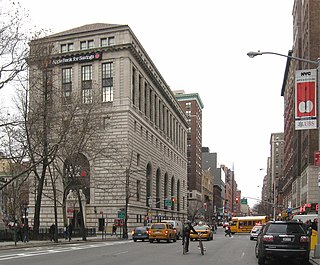
The Apple Bank Building, also known as the Central Savings Bank Building and 2100 Broadway, is a bank and residential building at 2100–2114 Broadway on the Upper West Side of Manhattan in New York City, New York, United States. Constructed as a branch of the Central Savings Bank from 1926 to 1928, it occupies a trapezoidal city block bounded by 73rd Street to the south, Amsterdam Avenue to the east, 74th Street to the north, and Broadway to the west. The Apple Bank Building was designed by York and Sawyer in the Renaissance Revival and palazzo styles, patterned after an Italian Renaissance-style palazzo.
